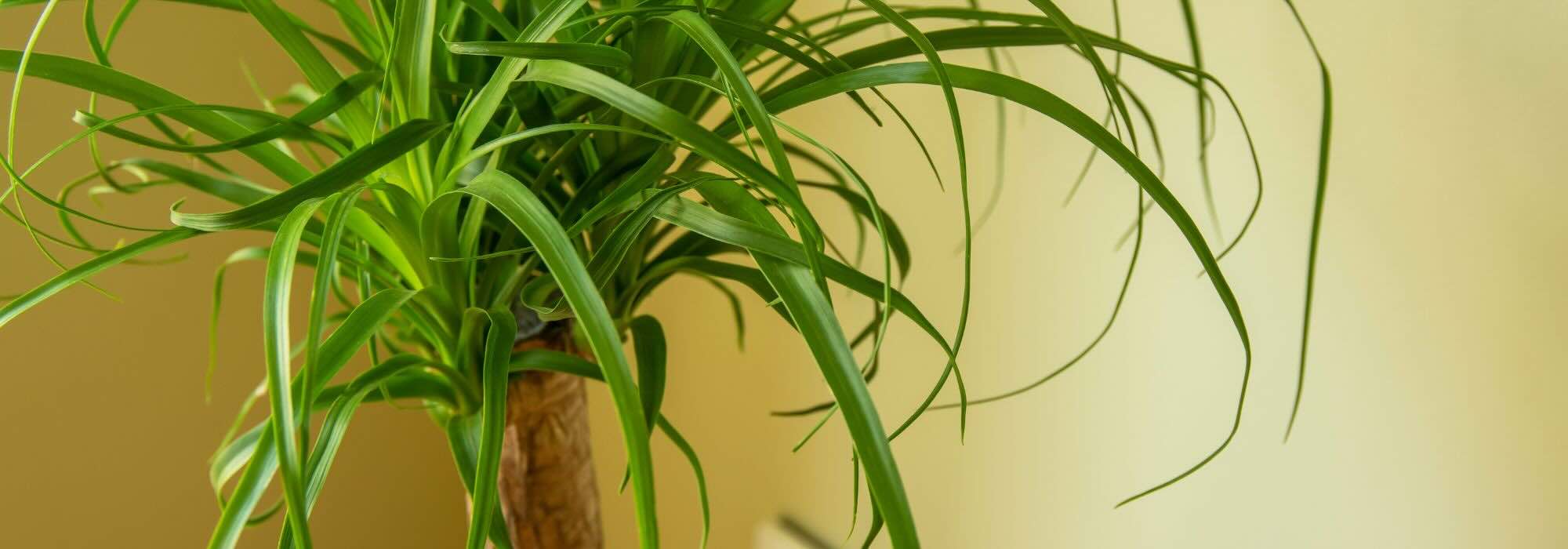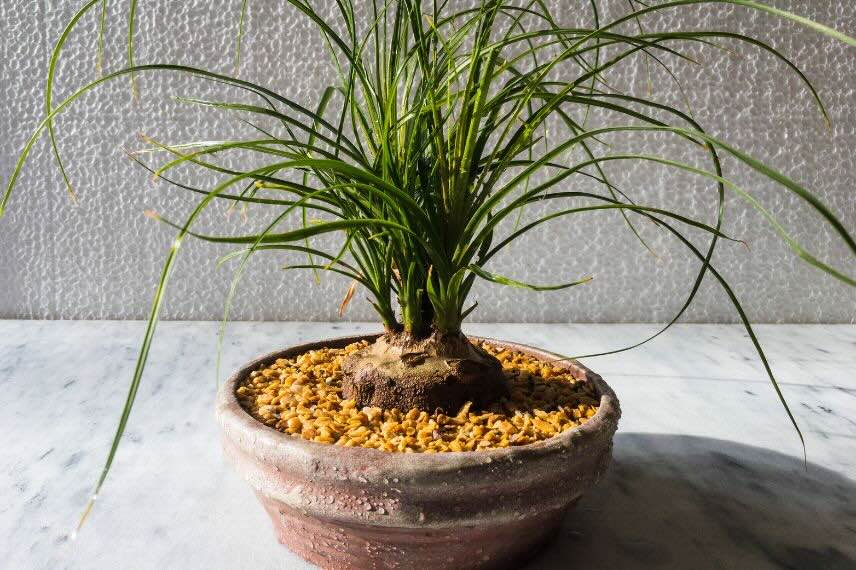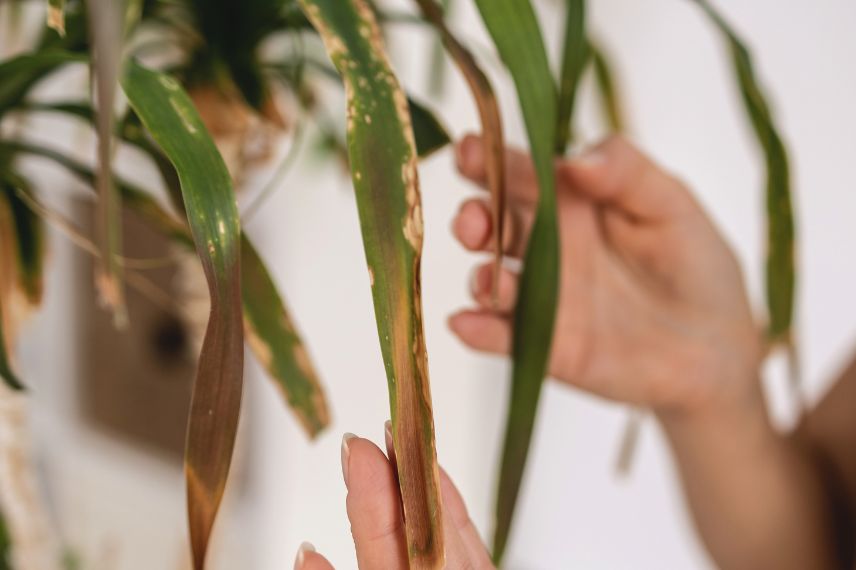
Beaucarnea or Elephant's Foot: Caring for This Houseplant Through the Seasons
All you need to know about the best care for its needs
Contents
The Beaucarnea recurvata, also known as Ponytail Palm or Bottle Tree, has the botanical synonym Nolina recurvata. It is a houseplant as unique as it is easy to care for. With a swollen trunk that stores water and long cascading leaves, it adds an exotic touch to any room. But like all plants, it has its little needs… which change with the seasons!
In this article, discover how to care for your Beaucarnea throughout the year, from spring awakening to winter rest, to keep it in top condition.
Spring – A Gentle Awakening
Spring is the season when the Beaucarnea gently emerges from its winter slumber. Now is the time to help it restart smoothly, without rushing. Here’s how:
Gradual Watering
During winter, watering is very infrequent. But as the days lengthen and light returns, the plant begins to “drink” a little more. You can start watering more regularly again, always allowing the compost to dry out completely between waterings. Once every two weeks is often enough at first. However, water carefully and deeply to ensure the substrate is thoroughly moistened. It’s best to water in two stages so the water penetrates the root ball properly. Avoid excess stagnant water on the surface or in the saucer, as this can encourage root rot.
Nutrient Boost
This is also the perfect time to give your Beaucarnea a little help. You can start adding a small amount of diluted liquid fertiliser for houseplants, no more than once a month. Be careful not to overdo it, as the trunk already stores plenty of water and nutrients. It’s also best to avoid slow-release fertilisers at this time, as their concentration can be hard to control and unsuitable for slow-growing plants like the Beaucarnea.
Cleaning and Maintenance
Spring is also the ideal time to:
- Dust the leaves with a damp cloth to help them breathe better
- Trim dry tips if needed (without cutting into the green parts)
- Rotate the pot a quarter turn every two weeks for balanced growth
These simple steps help revitalise the plant after winter. If any leaves are badly damaged or yellowed, they can be removed entirely at the base.
Repotting if Needed
If your Beaucarnea is starting to outgrow its pot (roots emerging, soil drying out extremely quickly), this is the perfect time to repot it into a slightly larger container with well-draining compost, such as a cactus mix, or standard compost mixed with sand and perlite. The new pot shouldn’t be too large, as excess damp substrate could harm the roots.

Spring is the ideal season to repot your Beaucarnea with a cactus-type substrate
Summer – Full Sun and Vigilance
Summer is the peak growth period for the Beaucarnea. It loves heat and light, but can suffer from excess. Here’s how to care for it with ease:
Plenty of light, but gently
Indoors, the Beaucarnea thrives in very bright rooms and tolerates some direct morning sunlight. You can place it outside during the warmer months, starting in partial shade, then gradually increasing sun exposure to acclimatise it. Protect it from wind and rain, and move it to shade during heatwaves. You can keep it outdoors from spring to autumn, provided nighttime temperatures stay above 5°C.
Once well-adjusted, it benefits fully from natural light, promoting denser foliage and better leaf colour. However, beware of reflective surfaces (like light-coloured tiled terraces or white walls), which can intensify heat and scorch the leaves.
Regular but controlled watering
In summer, the plant drinks more. Watering often increases to once a week, or slightly more in very hot weather. But the golden rule remains: let the compost dry out before watering again. The trunk stores water, so there’s no need to drown the plant!
Outdoors, water early in the morning or evening to avoid rapid evaporation, and check the substrate’s moisture more frequently.
Good ventilation is key
If the Beaucarnea stays indoors, ensure it’s in a well-ventilated room. Stuffy air and heat can encourage fungi or pests. Open windows to let it enjoy fresh air (but avoid direct draughts on the plant).
Watch out for pests
In summer, unwelcome little visitors may appear:
- Mealybugs: Recognisable by small white cottony clusters
- Spider mites: Tiny and hard to spot, they cause yellowing leaves and fine webbing
A regular wipe with a damp cloth or a spray of diluted black soap can keep them at bay. Check the undersides of leaves and the base of the foliage, as these areas are often infested first.
Fertiliser = boosted growth
Continue applying well-diluted liquid fertiliser every 4 weeks, always after watering to avoid root burn.

If possible, move your Beaucarnea outside in the warmer months
Autumn – Time to Slow Down
When the days grow shorter and temperatures begin to drop, the Beaucarnea gently enters its dormant phase.
Less Frequent Watering
Start spacing out watering, as the plant consumes less water. Generally, watering every two to three weeks is enough, or even less if the compost takes time to dry out. The idea is to avoid excess moisture, which could lead to root rot. Regularly checking the moisture level deep in the soil, using a finger or a wooden stick, helps prevent mistakes.
Stop Fertilising
From September or October, stop fertilising completely. The plant no longer needs nutrients during its dormant period. Too many nutrients at this time could even disrupt its natural cycle. Stopping fertilisation allows the Beaucarnea to slow its metabolism without artificial stimulation, prolonging its lifespan and respecting its biological rhythm.
Less Light? No Need to Panic
The Beaucarnea tolerates lower light levels quite well, but try to keep it in a bright room, near a window. Rotate it occasionally to maintain balanced growth. A south or west-facing exposure is ideal if direct sunlight remains moderate.
Light Maintenance
Autumn is also a good time to:
- Remove damaged or yellowing leaves
- Watch for pests that may hide as the plant slows its growth
It’s also an ideal time to observe the plant more closely. Check the condition of the compost: if it seems too compact, retains water for too long, or no longer drains properly, it can be replaced or lightened the following spring. Monitor the overall condition of the foliage. Regular inspections prevent minor issues from becoming problematic in winter.

In autumn, remove damaged leaves from the Elephant’s Foot
Winter – The Peaceful Pause
In winter, the Beaucarnea hardly grows and enters a dormant period.
Minimal watering
Watering becomes very occasional: approximately once a month, or even less if the soil remains moist for a long time. The most important thing is to observe the plant: the trunk should remain firm. A trunk that begins to soften or droop signals a need for water. This direct observation is more reliable than a fixed schedule. However, excess moisture in winter poses a risk of rot for caudate plants like the Elephant’s Foot.
Moderate temperature
The Beaucarnea dislikes the cold. Indoors, keep it at a temperature between 12 and 20°C. Most importantly:
- Avoid cold draughts
- Do not place it directly next to a radiator or on underfloor heating, as this can dry out its roots
Good light, but not excessive
Even though it doesn’t need much light in winter, keep it near a bright window. It won’t grow, but it will continue to absorb some energy. In case of low light, artificial lighting is unnecessary: the Beaucarnea can tolerate this darker period perfectly, provided watering is reduced accordingly.
No repotting, no pruning
This is clearly not the time to repot or prune. Any intervention would be unnecessary stress for a dormant plant. Even if the plant seems “frozen”, this is normal: the Beaucarnea follows a natural rhythm that allows it to regenerate. This rest period is beneficial for ensuring a smooth revival the following spring.
- Subscribe!
- Contents































Comments